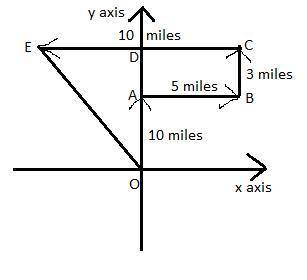
Physics, 19.09.2020 01:01 alupton4887
You are going for a drive, but a detour takes you out of the way of your destination. You
drive north for 10 miles, turn right and drive east for 5 miles, turn to the north and drive for 3
miles, drive west for 10 miles, and arrive at your destination.
a) How far from where you started did you end up?
b) If you wanted to travel directly to your destination without following the streets (“as the
crow flies”), what angle would you take? What direction would a compass read?
c) Now try adding the vectors in a different order. For example, start with the 5 miles east,
then 3 miles north, etc., as long as you add all four vectors. Compare the result to the sum
in part a). Draw the vectors in the order you used.

Answers: 3


Other questions on the subject: Physics

Physics, 21.06.2019 22:00, markyyy53
Aroll in a paper machine is powered by a separately excited dc machine. operating point 1 (under load): the roll typically operates at 764 rpm and must provide 301 nm of torque to oppose the load of the paper. the armature voltage is 230v for this operating point operating point 2 (no load): when the load is removed the speed of the roll increases to 900 rpm (the field characteristics are unchanged) la ea dev m (a) calculate the maximum torque (units of nm) that the motor can supply with this applied voltage (b) calculate the value of the armature resistance, ra (in ohms) (c) at operating point 1 (loaded condition), the field current, i, and the total input power (armature field), are measured to be to be 10 a and 28,600 w respectively. use this information to calculate the value of the field resistance, rf (in ohms). (d) (d) at operating point 1 (loaded condition), calculate the motor efficiency. express your answer as a percent to at least 2 significant digits. (d) if the field voltage is reduced by 1/2, calculate the new stall torque (in nm) of the motor (f). if the field voltage is reduced by 1/2, calculate the new no-load speed (in rad/sec)
Answers: 1

Physics, 21.06.2019 22:50, ijohnh14
If the temperature were raised very high, classically what would we expect the heat capacity per object to be for this one-dimensional system? give a numerical value. chigh t = __ j/k/object (one reason for the discrepancy is that the high-temperature limit assumes that the number of oscillators is large (n > > 1), which is not the case in this tiny system.)
Answers: 2

Physics, 22.06.2019 10:40, rainbowboi
As you are trying to move a heavy box of mass m, you realize that it is too heavy for you to lift by yourself. there is no one around to , so you attach an ideal pulley to the box and a massless rope to the ceiling, which you wrap around the pulley. you pull up on the rope to lift the box. use g for the magnitude of the acceleration due to gravity and neglect friction forces. once you have pulled hard enough to start the box moving upward, what is the magnitude f of the upward force you must apply to the rope to start raising the box with constant velocity? express the magnitude of the force in terms of m, the mass of the box.
Answers: 1

Physics, 22.06.2019 12:30, promcafee8788
Awheel of mass 48 kg is lifted to a height of 0.8 m. how much gravitational potential energy is added to the wheel? acceleration due to gravity is g = 9.8 m/s2. a. 30.4 j b. 3.1 j c. 297.9 j d. 11,321 j
Answers: 1
You know the right answer?
You are going for a drive, but a detour takes you out of the way of your destination. You
drive nor...
Questions in other subjects:

Social Studies, 24.01.2021 16:20

Medicine, 24.01.2021 16:20





Computers and Technology, 24.01.2021 16:20

English, 24.01.2021 16:20


Mathematics, 24.01.2021 16:20










